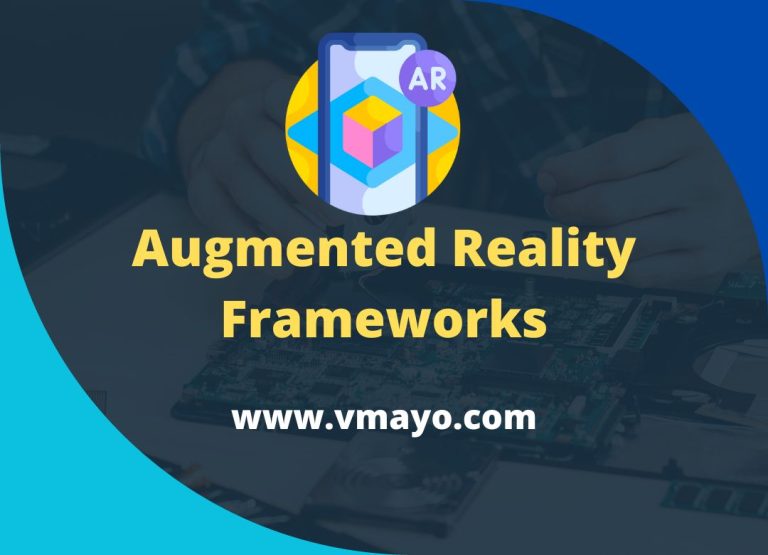Top 5 Augmented Reality Frameworks for App Development
Introduction
Augmented Reality (AR) is a technology that has transformed the way we interact with digital information and the physical world. It overlays digital content onto our real-world environment, offering exciting possibilities for various industries, from gaming and education to healthcare and marketing. If you’re considering developing AR applications, it’s crucial to choose the right framework to help you create immersive experiences efficiently. In this blog, we’ll explore the top 5 AR frameworks for app development.
-
ARKit (iOS) – Augmented Reality Frameworks
ARKit, developed by Apple, is a robust AR framework exclusively designed for iOS devices. It offers developers powerful tools to create high-quality AR experiences. ARKit provides features like motion tracking, environment understanding, and light estimation. These capabilities allow you to create apps that interact seamlessly with the real world. It’s a popular choice for AR app development, given its extensive user base and advanced capabilities.
Key features of ARKit:
- World tracking for precise 3D object placement.
- Scene understanding, enabling apps to interact with real-world objects.
- Persistent and shared experiences for collaborative AR applications.
-
ARCore (Android)- Augmented Reality Frameworks
ARCore is Google’s counterpart to ARKit, designed for Android devices. It’s an open-source platform that enables developers to build AR applications for a wide range of Android smartphones and tablets. ARCore offers three key functionalities: motion tracking, environmental understanding, and light estimation. This framework is constantly evolving, expanding the capabilities of AR development on Android devices.
Key features of ARCore :
- Cloud Anchors for shared AR experiences across devices.
- Augmented Images to recognize and augment 2D images.
- Augmented Faces for adding AR effects to facial features.
-
Unity 3D – Augmented Reality Frameworks
Unity 3D is a versatile and popular game development engine that has gained traction in the AR domain. It supports the creation of both 2D and 3D AR applications, making it an excellent choice for developers who want to build cross-platform AR experiences. Unity 3D offers a user-friendly interface and extensive support for AR development, including integration with ARKit and ARCore.
Key features of Unity 3D for AR:
- Cross-platform compatibility (iOS, Android, Windows, and more).
- Extensive asset store for AR development resources.
- Real-time rendering for immersive 3D AR experiences.
-
Vuforia – Augmented Reality Frameworks
Vuforia, owned by PTC, is a comprehensive AR development platform that specializes in computer vision and object recognition. It’s a powerful tool for creating marker-based and markerless AR applications. Vuforia’s target recognition and tracking capabilities make it an excellent choice for applications in industries such as education, retail, and manufacturing for Augmented Reality Frameworks.
Key features of Vuforia:
- Easy-to-use developer portal with drag-and-drop functionalities.
- Support for a wide range of devices and platforms.
- Cloud recognition for real-time updates of target images.
-
AR.js – Augmented Reality Frameworks
AR.js is an open-source AR framework that leverages web technologies like JavaScript and WebGL for creating web-based AR experiences. It’s an excellent choice for developers looking to build AR applications for the web, as it doesn’t require users to install dedicated apps. AR.js supports marker-based and location-based AR, making it accessible for a broad audience.
Key features of AR.js:
- Web-based AR experiences accessible via a web browser.
- Support for marker-based AR tracking.
- GPS-based AR for location-specific content.
Benefits and Future of Augmented Reality
Augmented Reality (AR) is a technology that has rapidly evolved and found its way into various industries. Its applications and potential benefits are numerous, and the future of AR holds even more promise. In this article, we’ll explore the benefits of AR and the exciting prospects it offers.
Benefits of Augmented Reality:
- Enhanced User Experience: AR overlays digital information on the real world, creating immersive and interactive experiences. Users can engage with content in a more engaging and enjoyable way, making it a valuable tool for entertainment, marketing, and education.
- Improved Learning and Training: AR is transforming the way we learn and train. In education, it can make complex subjects more understandable through interactive 3D models and simulations. In workforce training, employees can practice real-world scenarios in a safe, controlled environment.
- Efficient Remote Assistance: AR allows experts to provide remote assistance by overlaying information onto the user’s field of view. This is invaluable in fields like telemedicine, remote technical support, and equipment maintenance, reducing the need for physical presence.
- Increased Productivity: AR can streamline complex tasks by providing real-time data and instructions. In industries like manufacturing and logistics, workers can benefit from hands-free access to information, improving efficiency and accuracy.
- Innovative Marketing and Advertising: AR is a powerful tool for marketers. Brands can create engaging, interactive marketing campaigns that provide consumers with a unique and memorable experience. AR can also bridge the gap between print and digital media, adding digital content to physical advertisements.
- Navigation and Wayfinding: AR navigation apps enhance the way we find our way in unfamiliar places. They provide directions, points of interest, and local information, simplifying travel and exploration.
- Design and Visualization: In architecture, engineering, and product design, AR allows professionals to visualize and interact with 3D models in real-world environments. This aids in design validation and client presentations.
The Future of Augmented Reality:
- Widespread Adoption: AR is on a trajectory for mass adoption. As AR hardware becomes more accessible and affordable, we can expect to see more everyday applications and a broader user base.
- Seamless Integration: AR will become seamlessly integrated into daily life. Devices like smart glasses and AR-enhanced contact lenses are in development, making AR more unobtrusive and convenient.
- Medical Applications: In the healthcare sector, AR is expected to revolutionize surgical procedures, medical training, and patient care. Surgeons can access critical information and visualize patient data in real time during surgeries.
- Collaboration and Communication: AR will reshape how we collaborate and communicate. Virtual meetings and collaborative workspaces will become more immersive and interactive, reducing the barriers of distance.
- Entertainment Evolution: AR will redefine entertainment experiences. We can anticipate immersive AR gaming, interactive storytelling, and live event streaming enhanced by AR elements.
- Retail and Shopping: AR will transform the retail industry with virtual try-ons, product visualization, and personalized shopping experiences. Customers can see how products fit or look in their real-world environments before making a purchase.
- Environmental Sustainability: AR can contribute to sustainability efforts by offering real-time data on energy consumption, waste management, and environmental impact, helping individuals and organizations make more informed decisions.
- Training and Simulation: AR will continue to improve training and simulation across industries. Virtual reality (VR) and AR can merge to provide highly realistic and immersive training experiences for .
In conclusion, Augmented Reality presents numerous benefits across a wide range of applications, from enhancing user experiences to improving learning, efficiency, and innovation. Its future is filled with exciting possibilities, as it becomes more integrated into our daily lives and empowers us to interact with the world in new and meaningful ways. AR is poised to be a transformative technology, shaping the future of how we work, learn, communicate, and entertain ourselves.
Conclusion
Augmented Reality is a dynamic field with numerous opportunities for app development. Choosing the right AR framework is crucial to create immersive and user-friendly experiences. The top 5 AR frameworks mentioned in this blog offer a range of capabilities and compatibility, allowing developers to choose the one that best suits their project’s needs. Whether you’re developing for iOS or Android, or creating web-based AR experiences, there’s a framework that can help you bring your AR vision to life.





